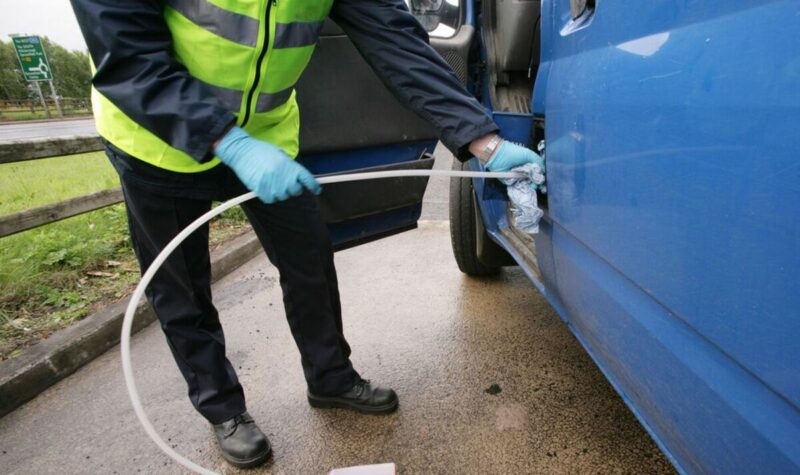
Businesses urged to take action against the rising threat of fuel theft
ShareFuel theft is an increasingly serious threat to businesses in the UK, affecting a wide range of industries. As fuel prices continue to rise and changes to red diesel subsidies take effect, the risk of theft has increased significantly, prompting businesses to seek solutions to protect their valuable resources. One such solution is the use of anti-theft dyes, which not only deter theft but also help in identifying stolen fuel. This article explores the impact of fuel theft in the UK, the factors contributing to its rise, and the benefits of using dyes to combat the problem.
The Impact of Fuel Theft in the UK
Fuel theft is a significant problem that affects various sectors, including agriculture, transportation, and construction. According to recent figures from NFU Mutual, fuel theft losses soared to nearly £900,000 in 2022, and almost doubled again in 2023. Construction and logistics businesses were particularly targeted due to the removal of red diesel subsidies, making the fuel more valuable to steal. And in 2024, nearly half of farmers reported that fuel theft was the type of rural crime about which they were most worried. However, the repercussions of fuel theft extend beyond immediate financial losses by affecting productivity, operational efficiency, and increasing insurance premiums, due to the damage caused to vehicles and storage facilities during theft attempts.

Economic Losses
The most immediate impact of fuel theft is the financial loss incurred due to stolen fuel. For businesses that rely heavily on fuel, such as logistics companies and farms, this can result in significant unexpected expenses that strain budgets. However, beyond the direct loss of fuel, businesses could also face an increase in operational costs, including repairing damages to tanks and vehicles caused during theft attempts. This can lead to downtime and reduced productivity, further compounding financial losses.
As fuel theft becomes more prevalent, insurance companies may further increase premiums for policies covering fuel and equipment, placing an additional financial burden on businesses.
Safety and Environmental Risks
Fuel theft often involves siphoning fuel from tanks, which poses safety risks to both the perpetrators and the environment. Spilled fuel can lead to fires and other hazards such as contaminating soil and water sources, leading to long-term environmental damage. This is particularly concerning in rural areas where agriculture and livestock rely on clean water and soil.
Impact on Supply Chains
Fuel theft can disrupt supply chains by causing delays and interruptions in transportation and logistics. This affects businesses that rely on timely deliveries and can lead to customer dissatisfaction. As businesses incur additional costs from fuel theft, they may be forced to pass these costs onto consumers, leading to higher prices for goods and services.
Factors Contributing to the Increasing Threat of Fuel Theft
Several factors have contributed to the rise in fuel theft in the UK, including rising fuel costs and changes in legislation regarding red diesel usage. Understanding these factors is crucial for developing effective strategies to combat theft.

Rising Fuel Costs
The cost-of-living crisis has increased the price of fuel significantly, particularly from the war in Ukraine and the COVID-19 pandemic. As fuel prices rise, the incentive for theft increases, as stolen fuel has become more valuable. These higher fuel prices strain the budgets of businesses and individuals alike, leading some criminals to resort to theft as a means of cutting costs.
Legislative Changes: Removal of Red Diesel Subsidies
An important fuel to discuss is red diesel, which is a lower-taxed fuel intended for use in specific industries like agriculture and construction. Red diesel has been subject to recent legislative changes, as the UK government announced the removal of subsidies for most sectors in April 2022, leading to increased costs for businesses that previously relied on this cheaper fuel.
This transition period for red diesel has created new opportunities for theft, as businesses may struggle to secure their fuel supplies effectively. Therefore, some of the additional costs now include the investment in new equipment and technology to mitigate the effect of criminals targeting tanks and vehicles containing this now more valuable resource.
Anti-Theft Dyes: A Solution to Fuel Theft
In response to the increasing threat of fuel theft, businesses are turning to new solutions such as anti-theft dyes. These dyes offer a practical and effective way to deter theft and assist in the recovery of stolen fuel.
How Anti-Theft Dyes Work
Anti-theft dyes work by changing the colour of the fuel, making it easily identifiable and less appealing to thieves. The visual alteration serves as a deterrent, as stolen dyed fuel is more challenging to sell or use without detection. In addition to acting as a deterrent, anti-theft dyes enable traceability of stolen fuel. If recovered, dyed fuel can be traced back to its source, aiding law enforcement in tracking down perpetrators and recovering stolen assets. Modern anti-theft dyes are also designed to comply with fuel legislation, ensuring that businesses remain within legal boundaries while protecting their assets.
Benefits of Anti-Theft Dyes
Compared to other security measures such as surveillance systems and fortified storage, anti-theft dyes offer a cost-effective solution to fuel theft. They require minimal investment and provide long-term protection. Anti-theft dyes can also be easily integrated into existing fuel management systems. They do not require significant changes to infrastructure, making them a practical choice for businesses of all sizes.
The presence of anti-theft dyes serves as a deterrent to criminals, reducing the likelihood of theft attempts. Criminals are less likely to target tanks and vehicles containing dyed fuel, as it is more challenging to sell or use without detection. By reducing the likelihood of theft and associated spills, anti-theft dyes are key to help protect the environment from contamination. This is particularly important in rural areas where agriculture and livestock rely on clean resources.
John Hogg’s Dyeguard Blue 673KNF: Leading the Way in Anti-Theft Dyes
One of the most effective anti-theft dyes on the market is John Hogg’s Dyeguard Blue 673KNF. This product offers a range of benefits that make it an ideal choice for businesses looking to protect their fuel supplies.
Key Features of Dyeguard Blue 673KNF
Compliance with Legislation:
Dyeguard Blue 673KNF is fully compliant with current fuel legislation (Regulation 14(3) of The Hydrocarbon Oil (Marking) Regulations 2002), ensuring that businesses can protect their fuel supplies without violating legal requirements.
Green Coloration:
Dyeguard Blue 673KNF imparts a green coloration to the fuel, when used at the prescribed dosage of 1L in 10,000L of fuel. This unique colour makes it easily identifiable and serves as a strong deterrent to potential thieves.
High Visibility:
The vibrant green colour of Dyeguard Blue 673KNF is highly visible, making it easy to detect and trace stolen fuel. This visibility aids in recovery efforts and serves as a deterrent to theft.
Easy Integration:
Dyeguard Blue 673KNF can be easily integrated into existing fuel management systems, allowing businesses to implement this solution without significant changes to their infrastructure.
Low Hazard Solvent:
Dyeguard Blue 673KNF is prepared in a low hazard solvent system, leading to reduced manual handling risks.
Benefits of Choosing Dyeguard Blue 673KNF
Enhanced Security:
By using Dyeguard Blue 673KNF, businesses can enhance the security of their fuel supplies, reducing the risk of theft and associated losses.
Cost Savings:
Investing in anti-theft dyes like Dyeguard Blue 673KNF can result in significant cost savings by preventing theft and reducing the need for additional security measures.
Environmental Protection:
Dyeguard Blue 673KNF helps protect the environment by reducing the likelihood of theft-related spills and contamination.
Support from Experts:
John Hogg provides expert support and guidance to businesses implementing Dyeguard Blue 673KNF, ensuring a smooth transition and effective protection.
Conclusion
Fuel theft is a pressing issue in the UK, driven by rising fuel costs and changes in legislation. The impact of theft extends beyond financial losses, affecting safety, the environment, and supply chains. As businesses and individuals seek effective solutions to combat this growing threat, anti-theft dyes offer a practical and cost-effective option.
John Hogg’s Dyeguard Blue 673KNF stands out as a leading choice in anti-theft dyes, providing compliance with legislation, high visibility, and ease of integration. By investing in innovative solutions like Dyeguard Blue 673KNF, businesses can protect their valuable fuel supplies, reduce costs, and contribute to a safer and more secure industry environment.
If you would like to learn more about Dyeguard Blue 673KNF, or any of our other anti-theft dye products, please contact us at hello@johnhogg.co.uk.



